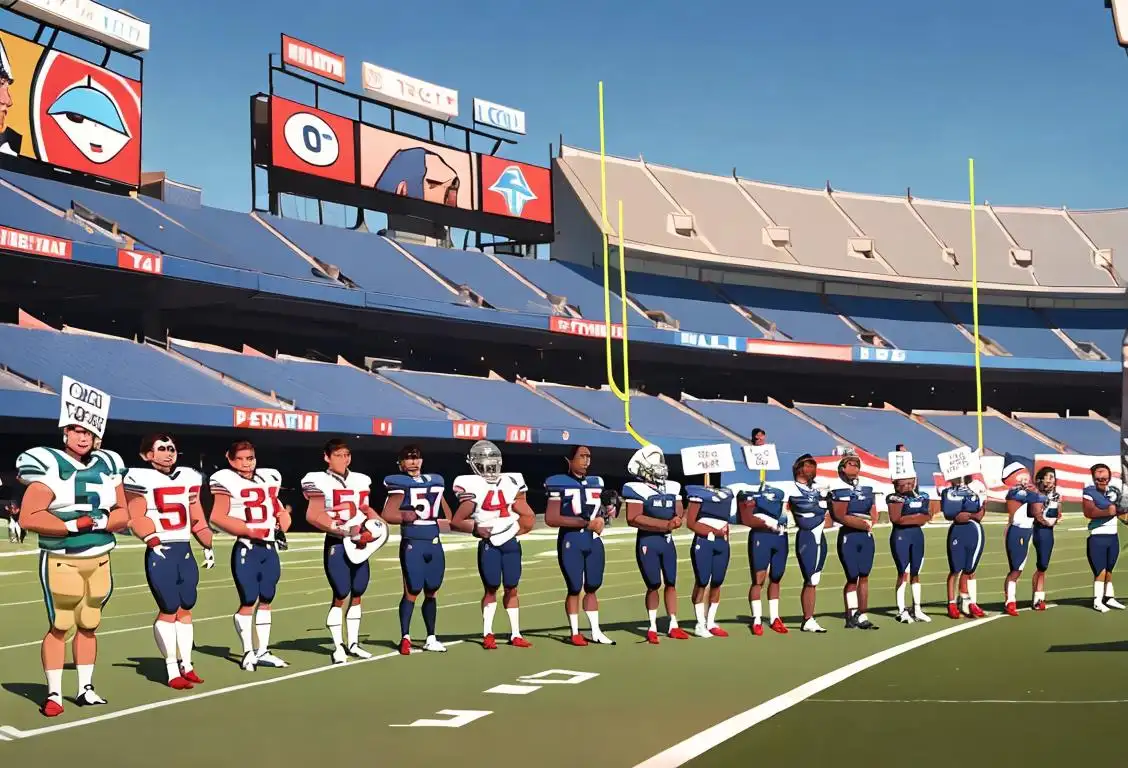National League Fixture Release Day

Welcome to National League Fixture Release Day! On this exciting day, football fans all over eagerly await the announcement of their team's upcoming matches. Whether you're a die-hard supporter or a casual observer, this day is sure to ignite your passion for the beautiful game. So get your jerseys ready, grab some snacks, and let's dive into the thrilling world of fixture releases!
When is League Fixture Release Day?
It's national league fixture release day on the 21st June.
The History of National League Fixture Release Day
While the internet doesn't boast a specific origin story for National League Fixture Release Day, the anticipation that surrounds this event is palpable. Every year, football clubs from the top tiers down to the grassroots level release their fixtures to fans, signaling the start of another exciting season.
Online discussions and speculations about fixture release dates and the implications of certain matchups can be found far and wide. From forums to social media, fans can't contain their excitement as they try to predict who their beloved team will face and when.
With the dawn of the internet age, the speed with which fixture lists spread has accelerated dramatically. The days of waiting for the local newspaper or tuning in to television broadcasts are long gone. Now, fans can instantly access their team's schedule at the click of a button, sharing in the collective joy or disappointment with fellow supporters from around the globe.
Fixture release day has become a significant event, with fans marking it on their calendars with utmost reverence. It's a chance to plan upcoming trips, organize meetups with friends, and set the stage for months of exhilarating football drama.
Did You Know?
Did you know that the announcement of fixture lists often leads to a surge in searches for travel and accommodation options near away games? Some fans take the opportunity to turn a match into a mini-vacation, exploring new cities and bonding with fellow supporters along the way. So not only is fixture release day about the football, but it also brings people together and creates lasting memories.
History behind the term 'League Fixture Release'
1863
The birth of league football
The Football Association (FA) was formed in England in 1863, marking the birth of organized football. At this time, there were no league fixtures as we know them today. Matches were arranged on an ad hoc basis, without a fixed schedule or league structure.
1888
The birth of league football
In 1888, the Football League, the first professional football league in the world, was established in England. This marked a significant moment in the history of football, as teams now had the opportunity to compete in a structured competition rather than relying solely on friendly matches. The introduction of the Football League laid the foundation for the concept of 'league fixtures' as teams began to play scheduled matches against each other.
1863
Formation of the Football Association
In 1863, the Football Association (FA) was formed in England, marking the beginning of organized football. The FA was primarily responsible for establishing rules and regulations for the game, as well as promoting its growth. At this early stage, there were no specific fixtures or schedules; matches were arranged on an ad hoc basis between clubs.
1863
The formation of the Football Association
In 1863, the Football Association was formed in England with the aim of standardizing the rules of football. This marked a significant moment in the history of the sport, as it laid the foundation for organized league competitions. At this point, the concept of a 'league fixture release' had not yet emerged.
1888
Formation of the Football League
In 1888, the Football League was founded in England, establishing a professional football competition. This marked a significant milestone in football history, as it brought together different teams to compete against each other in a structured manner.
1888
The Birth of League Football
In 1888, the Football League was established in England, marking the birth of organized league football. Prior to this, matches were primarily held between individual clubs. The league format brought structure and regularity to the game, allowing teams to compete against each other for a designated number of fixtures throughout a season.
1888
Formation of the Football League
In 1888, the Football League was formed in England, marking the beginning of organized football competitions. The league consisted of twelve clubs who played against each other twice, resulting in a total of 22 league fixtures per season.
1888
Formation of The Football League
In 1888, The Football League was formed in England, marking the beginning of organized professional football. This league consisted of twelve clubs, and its inaugural season took place in 1888-1889. The teams played a series of matches against each other to determine the league champion.
1863
The Birth of Football Associations
In 1863, the Football Association (FA) was founded in England, marking the birth of organized football. The FA aimed to establish a standardized set of rules for the game of football and to promote its development. This step was crucial in laying the groundwork for league fixtures.
1888
The establishment of the Football League
In 1888, the Football League was established in England, becoming the first organized football competition in the world. It consisted of 12 professional clubs and introduced a fixture list, which outlined the schedule of matches for each team throughout the season. This fixture list served as a guide for teams and fans, helping them plan and anticipate upcoming matches.
1888
The formation of the Football League
In 1888, the Football League was established in England, becoming the first organized league competition in the world. The league initially consisted of twelve clubs, and for the first time, a set fixture list was created. This allowed clubs to know in advance when and where they would be playing their opponents.
1920
Introduction of Fixture List
In 1920, the Football League introduced a fixture list system. This involved scheduling specific matches between teams, taking into account factors such as availability of stadiums and traveling distances. The fixture list served as a guide for organizing the league matches throughout the season.
1955
The publication of fixtures
By 1955, league fixtures were an integral part of the football calendar. Football fans eagerly awaited the announcement of the fixture schedule, which determined when and where their favorite teams would be playing throughout the season. The release of the league fixture list sparked excitement among supporters and provided them with an opportunity to plan their attendance at matches in advance.
1890
Introduction of a Fixture Release Date
By 1890, the popularity of the Football League had grown significantly, and fans eagerly awaited the announcement of the upcoming season's fixtures. To create buzz and anticipation, the league's governing body introduced a specific fixture release date, generating excitement among supporters and media alike.
1920
Introduction of Fixture Release
By 1920, the concept of 'fixture release' had been introduced, which refers to the announcement of the specific dates and opponents for each team's upcoming matches. This information is crucial for clubs, fans, and broadcasters to plan their schedules accordingly and anticipate the forthcoming games.
1888
Introduction of League Football
In 1888, the Football League was founded in England. This marked a significant milestone in the development of the sport as it introduced the concept of league football, where teams competed against each other in a scheduled series of matches. The introduction of league football meant that fixtures needed to be organized and released in advance to ensure fairness and proper planning.
1892
Introduction of Fixtures Release
By 1892, the Football League had gained popularity and anticipation grew among fans and players regarding the scheduling of matches for the upcoming season. To meet this demand, the Football League started releasing the league fixtures in advance, providing fans and clubs with the dates, venues, and opponents of their respective teams' matches. This marked the introduction of the 'league fixture release' tradition.
1888
Formation of the Football League
In 1888, the Football League was established in England, becoming the world's first professional football league. The league consisted of 12 founding clubs who agreed to play a series of fixtures against each other, both home and away, throughout the season. This marked the beginning of regular league fixtures in football.
1950s
Growth of Fixture Release as an Event
During the 1950s, the release of league fixtures started to gain more attention and became a notable event in the football calendar. Supporters eagerly awaited the fixture list, often gathered outside newspaper offices to be the first to see the published schedules, and clubs organized special events to reveal their fixtures to fans. The anticipation and excitement surrounding the fixture list release became a part of the football culture.
1920
Development of Fixture Release Procedures
As professional football continued to evolve, the Football League gradually refined its processes for the fixture release. In 1920, the League decided to create an official Fixture Committee responsible for determining the sequence and dates of each team's matches. This standardized approach ensured fairness and avoided any perceptions of favoritism in the scheduling of games.
1905
Expanding Fixtures with Divisional Structure
In 1905, the Football League underwent a major expansion, leading to the creation of multiple divisions. This expansion allowed for more clubs to participate in league football, but it also presented a challenge in terms of fixture organization. With the introduction of divisional structure, the fixtures needed to be arranged not only within each division but also for promotion and relegation matches between divisions.
1920
The formation of the Football League Division Three
In 1920, the Football League Division Three was introduced, initially as a single section. This expansion allowed for even more teams to participate in organized league football, increasing the demand for detailed fixture information. The 'league fixture release' became essential for clubs and supporters, offering certainty and excitement over the upcoming matches.
1920
The birth of the Football League fixture release
In 1920, the Football League fixture release became an official annual event. The fixtures would be released to the clubs and the public, marking a highly anticipated moment for football fans across the country. This tradition continues to this day, with supporters eager to find out who their team will face throughout the upcoming season.
Computerization
Advancements in fixture release
With the advent of computer technology in the late 20th century, the process of league fixture release underwent significant improvements. Computerized systems enabled fixture compilers to consider various factors, such as team preferences, geographical proximity, and balancing home and away matches. This increased the efficiency and fairness of fixture scheduling, ensuring a more balanced competition for all teams involved.
1920
Introduction of Fixtures Committee
In 1920, the English Football League formed the Fixtures Committee to handle the scheduling of league fixtures. The committee's responsibility was to determine the dates and venues for all matches in a fair and balanced manner. This step helped ensure that each team faced every other team both at home and away during the season.
1920
Central Fixture Planning
In 1920, the Football League centralized the planning and scheduling of fixtures. This allowed for better coordination and avoided conflicts in match dates, ensuring smooth operations for clubs and fans. Centralized fixture planning became a fundamental element of league management, providing structure and order to the competition.
Post-World War II era
Fixture Release Tradition
Over the years, the process of announcing the league fixtures evolved into a highly anticipated event for football fans. The fixture release tradition gained traction, with leagues and clubs creating a sense of excitement by revealing the upcoming season's schedule. It became an opportunity for fans to start planning their attendance at matches and building anticipation for the season ahead.
1939
Postponement due to World War II
The outbreak of World War II in 1939 had a significant impact on football fixtures. The league fixtures were temporarily suspended, and professional football was put on hold as many players joined the war effort. The interruption caused by the war not only affected the release of fixtures but also altered the course of several seasons and disrupted the continuity of the game.
1958
The advent of fixture release dates
By the late 1950s, the practice of announcing fixture release dates became more commonplace. Football clubs started to provide official notifications of their upcoming fixtures, generating anticipation and allowing supporters to plan their attendance in advance. This tradition continues up to the present day.
1969
Fixture Release Day Tradition
By the late 1960s, the concept of a 'fixture release day' had become deeply ingrained in the football culture. The announcement of the league fixtures evolved into an annual event celebrated by fans, creating a sense of anticipation and excitement as supporters anxiously awaited discovering who their team will face throughout the season.
Mid-20th Century
Growing Spectacle and Media Coverage
Throughout the mid-20th century, league football gained immense popularity, with matches attracting large crowds and increased media attention. The release of league fixtures became a highly anticipated event, generating buzz and excitement among fans nationwide, as they eagerly awaited the schedules of their beloved clubs. Newspapers started dedicating special sections to showcase the fixture lists, feeding the enthusiasm of passionate football followers.
Modern Transformation
Digital and Media Influence
With the advent of the internet and digital media, the league fixture release process underwent a transformation. Football authorities and clubs started utilizing various online platforms and social media channels to announce fixture lists. This digital shift enabled a broader reach and increased engagement among fans worldwide, as they could access the schedules with ease.
1992
Creation of the Premier League
In 1992, the English First Division was restructured and transformed into the FA Premier League, which introduced significant changes to the league system. The creation of the Premier League introduced a new era in football, with increased revenue, television coverage, and global popularity. The league fixtures became highly anticipated events each season.
1960s
The advent of televised fixture release
With the increasing popularity of television in the 1960s, the Football League fixture release took on a new dimension. The event became televised, allowing fans to witness the unveiling of the fixtures in real-time. This added an element of excitement and anticipation to the process, further engaging supporters.
1990s
Digital Era and Online Release
With the advent of the internet and digital technology in the 1990s, the process of fixture release evolved further. Instead of relying solely on traditional media outlets, clubs and football governing bodies started publishing fixtures directly online. This allowed fans from all over the world to access the information simultaneously, increasing the global reach and immediacy of fixture release.
2003
Digitalization and Instantaneous Access
With the rise of the internet and digital technology, the process of releasing league fixtures underwent a significant change. Beginning in 2003, fixture lists became readily available online, allowing fans instant access to the schedules of their favorite teams. This digitalization transformed the way fans engaged with the fixture release, making it more accessible and convenient than ever before.
Present
Continuation and Global Adoption
League fixture release has become an annual tradition in football leagues worldwide. Fans eagerly await the announcement of the upcoming season's fixtures, as it allows them to plan their match attendance and follow their favorite teams' journeys. The term 'league fixture release' has become a significant event in the football calendar, generating excitement and anticipation among football enthusiasts globally.
1950
Standardization of the Fixture Release
By the 1950s, the process of releasing league fixtures became more standardized. The Football League began coordinating fixtures with clubs to ensure a fair and balanced schedule for all teams. The release of the fixtures started to garner significant attention from fans and media, generating excitement and anticipation for the upcoming season.
1981
Advancements in fixture scheduling
In 1981, the Football League introduced a computerized fixture scheduling system. This innovation optimized the process of arranging fixtures, taking into account various factors such as club preferences, geographical considerations, and television broadcast requirements. The introduction of computerized scheduling significantly improved the efficiency and accuracy of fixture releases.
Present
Modern Fixture Release Practices
Today, fixture release has become a highly anticipated event for football enthusiasts across different leagues worldwide. It is common for clubs to unveil their fixtures through carefully planned marketing campaigns, utilizing social media platforms and broadcasting live announcements. The fixture release generates excitement among fans who eagerly analyze the schedule, marking key matchups and eagerly anticipating the start of the season.
21st Century
Digital Age and Instant Gratification
With the advent of the internet and digital media, the anticipation surrounding the league fixture release took on new dimensions. Football leagues began publishing the fixture lists on their official websites, allowing fans to access the information instantaneously. Social media platforms further amplified the buzz, enabling clubs and fans to engage in discussions, predictions, and excitement surrounding the upcoming season's schedule. The league fixture release event transitioned into a digital spectacle, captivating football enthusiasts worldwide.
Digital age
The digital revolution of fixture release
With the advent of the internet and online media, the release of league fixtures entered the digital age. Clubs and official football websites started publishing the fixtures online, making them instantly accessible to fans worldwide. Social media platforms also played a significant role, allowing fans to share and discuss the fixture list across various online communities.
Present day
Digital media and global accessibility
In the present day, with the advent of digital media and the internet, the 'league fixture release' has become a highly anticipated event for football fans worldwide. Fixture lists are now readily accessible through official club websites, social media platforms, and dedicated sports news outlets. The internet has enabled supporters from all corners of the globe to engage with their favorite teams' schedules and plan their football-watching activities accordingly.
1992
Formation of the Premier League
In 1992, the Premier League was formed, separating the top clubs from the Football League and creating a new elite division in English football. With this new division, the fixture release gained even more significance as fans eagerly awaited the schedule to see when their favorite teams would face off against top rivals. The Premier League fixture release became an annual event, generating excitement and discussion among both fans and pundits.
Did you know?
Did you know that the announcement of fixture lists often leads to a surge in searches for travel and accommodation options near away games?Tagged
sportsFirst identified
20th June 2018Most mentioned on
21st June 2018Total mentions
9Other days
Boycott Of The Nfl Day
Golf Day
Gymnastics Day
Cancer Survivors Day
Fitness Day
Memorial Day
Dance Day
Jr Smith Day
Foundation Day
Hunting And Fishing Day









